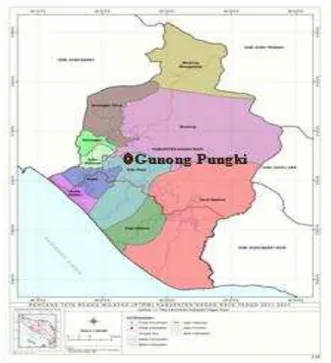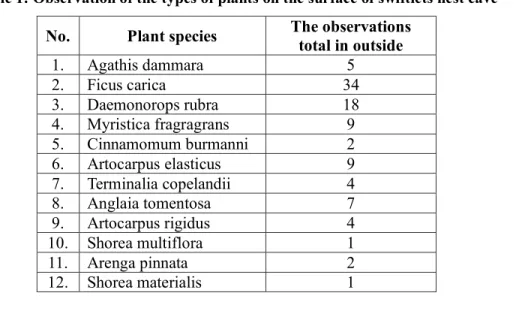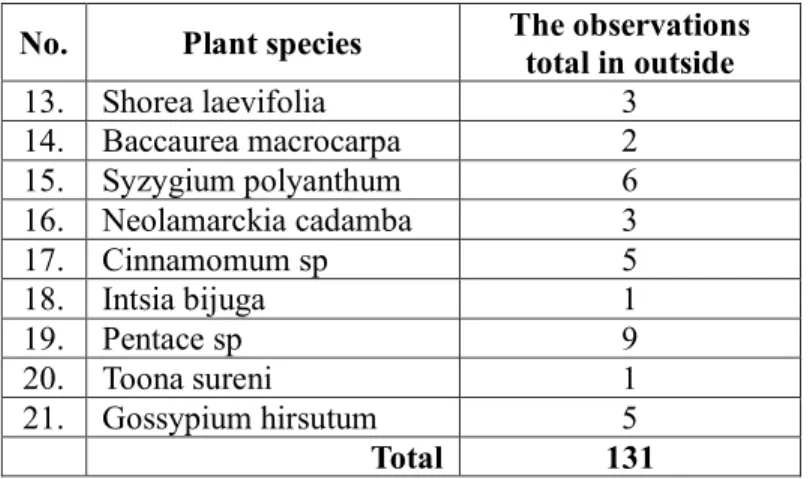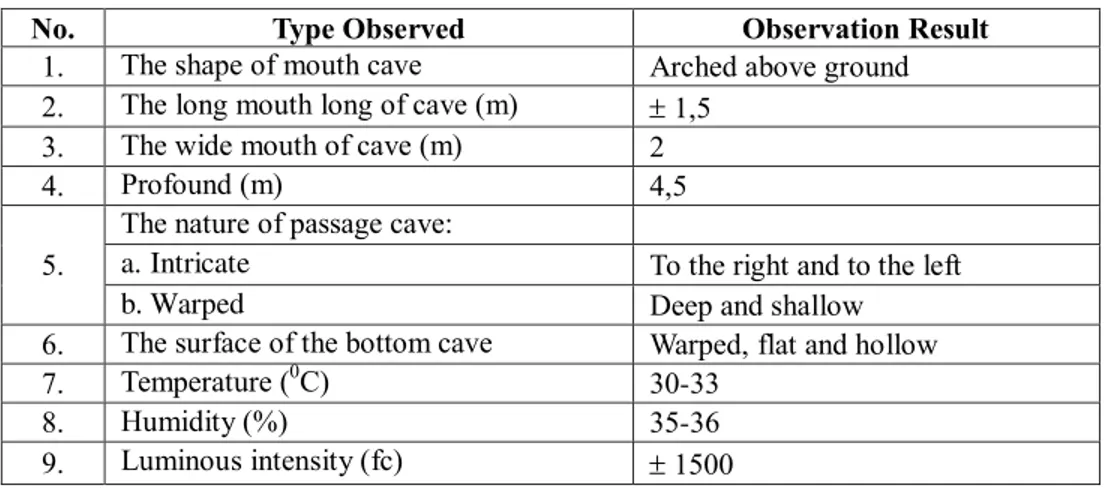DOI : 10.18843/rwjasc/v6i4/12 DOI URL : http://dx.doi.org/10.18843/rwjasc/v6i4/12
MORPHOLOGY CHARACTERISTICS OF SWIFTLET’S
NEST
NATURAL HABITATS (CAVE) IN GUNONG PUNGKI TADU
RAYA THE DISTRICT NAGAN RAYA
Said Nazaruddin,
Graduate Student, Master of Biology
Education, Syiah Kuala University,
Indonesia.
Abdullah,
Lecturer Graduate,
Syiah Kuala University, Indonesia.
M. Ali. S,
Lecturer Graduate,
Syiah Kuala University, Indonesia.
Jalaluddin
Lecturer,
Serambi Mekkah University, Indonesia
ABSTRACT
This research was conducted by survey method with 2 stages of research. Data was collected through observation and recording. Data was analyzed using descriptive analysis. Observations showed that the outside surface of the cave there are many species of plants totaling 131 trees of 21 species and 39 animals of 11 species that live on the surface of the cave swiftlet habitat. The inner surface is generally smooth and watery caves and has temperature and humidity are very cool compared to the outside surface of the cave. On walls and ceilings inside the cave there are small bumps that are used to create a nest swiftlet. The surface of the cave has a light intensity of 001 foot candles. The conclusion obtained is the outer surface of bird's nest cave has a surface is not flat and overgrown with various species of trees, while the inside has a surface with small protrusions with holes not too deep.
INTRODUCTION:
Swiftlet (Aerodramus sp) is a bird that is very unique, because this bird has a habit of foraging by way of darting in the air to catch small insects. In addition, this bird is also a bird that is aerial and like gliding. The bird's nest is recognized as a health food source of the prestigious and winning (Mei Yang., Sau-Ha Cheung, Sze Chun Li., and Hon-Yeung, 2014). 90% of people use the Chinese a bird nest in their cooking Swallow nest is made from the saliva of swallow. Swiftlets nest are beneficial to health and delicacy in nature with high nutrient content (Marcone, 2005; Olsen, P. S., Poulsen, S. S., Kirkegaard, P., and Nexø, E. 1984).
Protein contained in the swiftlet’s nest is 62-63% and carbohydrates is it 25,26% and 27,26% (Oda, M., Ohta, S., Suga, T and Aoki, T. 1998). In addition, swiftlets nest can inhibit influenza virus infection, accelerate the recovery of the disease, stimulating the appetite, aid digestion strengthens the lungs and boost immunity (Guo, C. T., Takahashi, T., Bukawa, W., Takahashi, N., Yagi, H., Kato, K., Hidari, K. J., Miyamoto, D., Suzuki, T., and Suzuki, Y. 2006; Mei Yang, 2014).
Swiftlets usually live in cave especially dark ones. Swiftlet are capable of detecting nest (echolocation) in the dark similar to bats. Swiftlet nest breeding in the cave, by utilizing the cave walls, ceilings are curved and have small bumps found on cave walls to make a nest. Swiftlet excretes a gelatinous secretion which is located under the tongue which serves to bind the materials to make nests that are often referred to as a nest cement (R,. Suriya and Zakaria, Zunita and Yusoff, Rosnina and A., Fadzillah and Hassan, Latiffah, 2004).
Gunong Pungki is one of the mountains in the Tadu Raya district of Nagan Raya. In Gunong Pungki region, there is a cave inhabited by the swiftlets, which is managed by the local community. The cave has been a natural habitat to swiftlet for a long time, but the people were not aware of its benefits of the swiftlets nest. The swiftlets nest cave natural habitat occupied swiftlet Gunong Pungki region, has its own morphology characteristics based on its place. This is what researchers want to examine to determine the characteristics of the surface morphology and the outer surface of the cave in Gunong Pungki. Moreover, the presence of this study are expected to be able to know the people around the cave caves morphological characteristics and also the benefit of bird nest that is in the cave.
MATERIAL AND MENTHODS:
This study was conducted between May 2014 to June 2014. The research activities carried out in the Gunong Pungki Tadu Raya District Nagan Raya were shown in the Figure-1.
The tools used in this study are digital cameras, notebooks, polpen. The materials used in this study is the birds' nest caves, plants and animals that exist around the cave.
The method used in this study is a survey method that is divided into two phases: pre-survey and survey stage. Pre-stage survey was conducted to observe the initial location around Cave a natural swiftlets nest. Phase survey was conducted to collect the data needed to record the types of plants, animals that are around the cave, the morphology characteristics of the surface and the outer surface morphology cave in Gunong Pungki Tadu Rata District of Nagan Raya.
Technique for Getting Samples:
The swiftlets nest cave divided into 2 places of observation, namely the upper / outer cave swiftlet nest and the inner surface of bird's nest cave. Retrieval of research data on the upper surface of the cave swiftlet nests made by observing the types of plants and animals on cave swiftlet nests. On the outer surface of the cave also observed the surface morphology on the ground lining the cave. The surface of the cave was directly observed. Observation of the dark cave lit by torchlight, and the cave ceiling was observed using a bamboo ladder.
Technique for Collecting Data:
Collecting data with field observation and recording. Field observation conducted to present the data by direct observation at the location of the research object (Tika, 2005). The data of various flora and fauna was captured around the cave, noting the condition of the outer surface morphology and events morphology of the inner cave swiftlet nest.
Statistical Analysis:
Analysis statistical was performed in a descriptive way. Descriptive analysis by representation on the symptoms of the problem under study. All data that have been obtained are collected, processed and presented in the form of a frequency table. The outer surface and morphological data in the record describing the data. The data have been included in the table observations serve as the basis for explaining the phenomena that occur in the field.
RESULTS AND DISCUSSION:
1.Conditions upper surface and a lower surface of bird's nest cave in Gunong Pungki
Plants that live on the surface of swallow amounted to 131 trees of 21 species (Table-1). The dominant species growing on the surface of the cave is a species of Ficus carica totaling 34 trees.
Table 1: Observation of the types of plants on the surface of swiftlets nest cave
No. Plant species The observations total in outside
1. Agathis dammara 5
2. Ficus carica 34
3. Daemonorops rubra 18
4. Myristica fragragrans 9
5. Cinnamomum burmanni 2
6. Artocarpus elasticus 9
7. Terminalia copelandii 4
8. Anglaia tomentosa 7
9. Artocarpus rigidus 4
10. Shorea multiflora 1
11. Arenga pinnata 2
No. Plant species The observations total in outside
13. Shorea laevifolia 3
14. Baccaurea macrocarpa 2
15. Syzygium polyanthum 6
16. Neolamarckia cadamba 3
17. Cinnamomum sp 5
18. Intsia bijuga 1
19. Pentacesp 9
20. Toona sureni 1
21. Gossypium hirsutum 5
Total 131
Price (2004), notes that external morphology of swiftlets nest cave overgrown with various types of plants. Chantler, P., Well, D. R and Schuchmann, K. L. 2000, said that morphological characteristics of swiftlets nest vary from one to another. Swiftlets nest caves overgrown with various types of vegetation around the nest to keep the humidity and temperature in the cave.
This is highly favored by the swiftlets nest, because the plant is a lot of small insects is preferable swiftlet. Ismail (1999), say that swiftlet nest caves overgrown with various types of plants that can invite the swiftlets nest. Plants that live in surrounding caves are generally not very large and high, covered only by the size of the cave is the average height of 5 meters were shown in the Figure-2.
Figure 2. The types of plants that live on top of a cave
Animals that live on the surface of the cave are 39 of 11 species (Table-2). The dominant species of life on the surface of the cave is a species of Mabuya multifasciata totaled 10 tails. The while swiftlets nest cave in only 4 animals of 3 species. The dominant species live in caves similar to those living on the surface of the cave which amounted to 2 tails.
Table 2: Observation of the types of animals on the surface of swiftlets nest cave
No. Animal Species Outside Lacition ObservationInside
1. Morelia viridis 3 -
2. Sus scrofa 5 -
3. Cervus unicolor 1 -
4. Tragulus javanicus 1 -
5. Mabuya multifasciata 10 2
No. Animal Species Outside Lacition ObservationInside
7. Gonyosoma oxycephalum - 1
8. Macaca fascicularisfuscus 5 -
9. Dendrelaphis pictus 2 -
10. Oligodon octolineatus - 1
11. Anthreptes malacensis 5 -
12. Geopelia striata 2 -
13. Coturnix Japonica 3 -
Total 39 4
The cave is a place of life for certain living creatures. The upper surface of the cave overgrown with various species of plants to cover the surface of the cave and keep moisture in the cave. In addition, there are also different types of animals that live on or inside the cave. Barton (2006) states that plants and animals can live on the surface of the cave. Whittaker (1969) also notes that the cave has a certain appeal to a wide range of animal species can live in a cave or on the surface of the cave were shown in the Figure-3.
Figure 3. Animals that live inside and outside the cave
The morphology of the outer and inner morphology of swiftlets nest cave:
Morphological characteristics of the outer and inner cave bird nest in Gunong Pungki presented in Table-3.
Table 3: The condition of the outside and the inside of the cave nest swiftlet
No Condition OutsideLocation ObservationsInside
1. The area surface cave (m) 3-4 1,5-5
2. High-level cave (m) 4-4,5 2 - 7
3. The Long cave surface (m) 25 100
4. The wall surface of the cave Slippery and moist Slippery and dry
5. The sky caves There is a bulge There is a bulge
6. Surface protrusions cave Small and large Small and large 7. Floor caves Ground stone and water Water and stone
8. The state of cave Light and dark Dark
9. Ground 2 mm Stone
10. Temperature (0C) 30
-31 25-28
11. Humidity (%) 36-38 29-31
The outer surface of bird's nest cave has a surface area of 3 to 4 meters with a height of cave surface 4 to 4.5 meters. Length of the outer surface of the cave 25 meters and has a wall that is smooth and watery were shown in the Figure-4. The outer surface of the cave floor is rocky and watery. On the outer surface of the cave has a relatively moderate temperature that is 30-31% with 36-38% humidity were shown in the Figure-5. Circumstances beyond the cave there is a dark part and a light part.
Figure 4. The outer surface of the cave Figure 5. Temperature and humidity
outside the cave
The outer surface of the cave has a high surface area of 1.5 m by 2.5 m. Curve-shaped mouth of the cave and tree trunks laid out so that the mouth of the cave is not clearly visible were shown in the Figure-6. The outer surface of the cave usually has ground to a thickness of 10mm and there is also a rocky surface. The surface of the floor of the cave overgrown with ferns and other tree species.
Figure-6. The outer surface of the cave mouth
The surface of the cave has an area ranging from 1-5m with an average height of 2-7 m and has a length of 100 m. The inner surface of the cave only had rocks and slippery floors and watery. Wall and ceiling surfaces in the cave are generally smooth and rock protrusions.
Morphology in the mouth of the cave:
Morphological characteristics parts of the cave are presented in Table- 4 below.
Table 4: The condition of the outside and the inside of the cave nest swiftlet
No. Type Observed Observation Result
1. The shape of mouth cave Arched above ground 2. The long mouth long of cave (m) 1,5
3. The wide mouth of cave (m) 2
4. Profound (m) 4,5
5.
The nature of passage cave:
a.Intricate To the right and to the left
b.Warped Deep and shallow
6. The surface of the bottom cave Warped, flat and hollow
7. Temperature (0C) 30
-33
8. Humidity (%) 35-36
9. Luminous intensity (fc) 1500
CONCLUSION:
This given research, people around the cave and also the researchers themselves and other people can find out about how the morphological characteristics of the cave in Gunong Pungki and for other researchers are expected to examine more deeply about the morphology of the cave as the environmental factors around the cave and others.
REFERENCES:
[1] Barton, H. A. (2006). Introduction To Cave Microbiology: A Review For The Non-Specialist. Journal of Cave and Karst Studies. 68 (2): 43-54
[2] Chantler, P. and Driessens, G. (1995). Swifts, a Guide to the Swifts and Treeswifts of the World. /Pica Press, Sussex, UK
[3] Chantler, P., Wells, D. R. and Schuchmann, K. L. (2000). Family Apodidae (Swifts). Handbook of the Birds of the World. 5: 338-457
[4] Fenton, M. B. (1975). Acuity of echolocation in Collocalia Hirundinacea (Aves: Apodidae), with comments on the distributions of echolocating swiftlets and molossid bats. Journal Biotropica 7: 1-7 [5] Guo, C. T., Takahashi, T., Bukawa, W., Takahashi, N., Yagi, H., Kato, K., Hidari, K. J.,
Miyamoto, D., Suzuki, T., and Suzuki, Y. (2006). Edible bird’s nest extract inhibits influenza virus infection. Antiviral Research. 70(3): 140-146
[6] Ismail, M.Y. (1999). Social Control and Bird's Nest Harvesting among the Idahan: A Preliminary Observation. Southeast Asian Studies. 35(1): 3-17
[7] Marcone, M. F. (2005). Characterization of the Edible Bird’s Nest the ‘‘Caviar of The East’’. Food Research International. 38(10): 1125–1134
[8] Medway, Lord (1967). The function of echonavigation among swiftlets. Journal Animal Behavior. 15: 416-420
[9] Mei Yang., Sau-Ha Cheung., Sze Chun Li., and Hon-Yeung Cheung. (2014). Establishment of a Holistic and Scientific Protocol for the Authentication and Quality Assurance of Edible Bird’s Nest. Food Chemistry. 151: 271-278
[10]Oda, M., Ohta, S., Suga, T and Aoki, T. (1998). Study on food components: The Structure of N-Linked Asialo Carbohydrate From the Edible Bird’s Nest Built by Collocalia Fuciphaga.Journal of Agricultural and Food Chemistry. 46(8): 3047–3053
[12]Prince, J. J., Johnson, K. P., and Clayton, D. H. (2004). The Evolution of Echolocation in Swiftlet. Journal of Avian Biology. 35: 135-143
[13]R,. Suriya and Zakaria, Zunita and Yusoff, Rosnina and A., Fadzillah and Hassan, Latiffah. (2004). Preliminary in-vitro Study on Antibacterial Activity of Swiftlet Bird’s Nests. Conference of the Association of Institutions for Tropical Vegerinary Medicine. 11: 344-345 [14]Tika, P. (2005). Metode Penelitian Geografi. Jakarta : PT Bumi Aksara
[15]Whittaker, R.H. (1969). New concepts of kingdoms of organisms. Evolutionary relations are better represented by new classications than by the traditional two kingdoms: Science,V. 163, P. 150–160.





